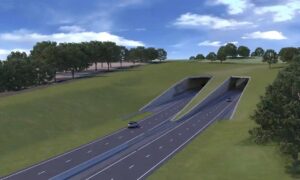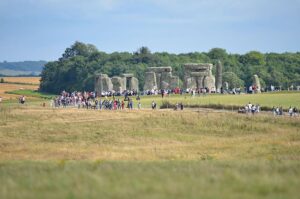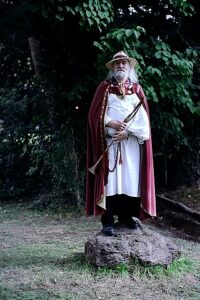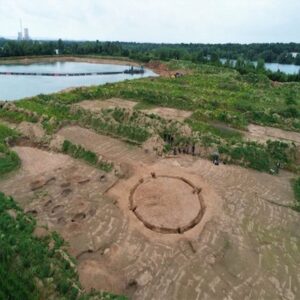Stonehenge Tunnel No More
When Henry James visited Stonehenge in the 1870s, he noted that the site was already popular with tourists and picnickers, but his overwhelming impression was of the monoliths’ solitude and mystique.
“It stands as lonely in history as it does on the great plain, whose many-tinted green waves, as they roll away from it, seem to symbolize the ebb of the long centuries which have left it so portentously unexplained.”

A303(T) Queues at Stonehenge, 5 August 2005, photo Pam Brophy, CCA-SA 2.0 license.
Two very different monuments to human achievement lie side by side on England’s Salisbury Plain: Stonehenge and the A303 highway. Stonehenge, as everyone knows, is an ancient and still mysterious monolith circle, long studied by archaeologists, admired by tourists, and revered by Neo-Pagans and Druidic revivalists. The A303, on the other hand, is one of the main arterial highways crossing England. Unfortunately, this highway also runs within a half-mile of Stonehenge itself. The route is often the site of long traffic jams – caused in part by the tendency of drivers to slow down and stare when passing by Stonehenge, one of the world’s most recognizable historic sites.
For years, Highways England, the government-run company in charge of the country’s highways, has sought to undertake a major reconstruction of the A303, to widen it from two lanes to four and to move a two-mile stretch of the highway into an underground tunnel. This tunnel would run directly through land adjacent to Stonehenge, potentially destroying still-buried ruins or other artifacts and imperiling its status as a UNESCO World Heritage Site.

Stonehenge tunnel mock-up 2021, English Highways.
The tunnel project faced strong opposition from archaeologists, preservationists, and Druid and Pagan communities, who are concerned about the tunnel’s impact on the surrounding area and the site’s cultural significance. The tunnel sparked fears among archaeologists that it could damage nearby archaeological sites, such as Blick Mead, that may include a wealth of additional archaeological sites, graves, and artifacts. The construction process could also accelerate the deterioration of artifacts, potentially erasing important aspects of Stonehenge’s history.
Another major concern was that the tunnel entrance would obstruct the view of the setting sun during the winter solstice, a significant event for those who celebrate rites at Stonehenge. A 50-meter shift in the tunnel’s entrance in the final plan was suggested in order to preserve this view.

Tourists around Stonehenge, 13 August 2013, Photo credit Steven Lek, CCA-SA 4.0 International license.
In November 2020, Grant Shapps, the Transport Secretary, approved a plan for the tunnel, despite popular outcry headed by the citizens’ group Save Stonehenge World Heritage Site (SSWHS). SSWHS brought an immediate legal challenge to the project’s 2020 approval. This came before the UK’s High Court in 2021, when the Court ruled that the transport secretary’s approval of the project was unlawful, due to the inadequate effort by the government to assess the risks to each asset at the site and its failure to consider alternatives to the proposed tunnel project that were required under common law.
Objections to the tunnel came from UNESCO as well. In 2021, UNESCO issued a warning that, should the highway revision go forward as planned, Stonehenge would be moved to their list of World Heritage Sites in Danger. UNESCO’s concerns were founded on the projected changes to the site, and the risks those changes would pose to Stonehenge’s historic integrity and that of the surrounding region. This threat to de-list Stonehenge was not realized, but in July 2024, the UNESCO World Heritage Committee again considered adding Stonehenge to its World Heritage in Danger list, indicating that it could do so if the site continued to be threatened.

Rollo Maughfling, Archdruid of Stonehenge & Britain at Green Man Festival, 17 August 2018, photo Simon King, CCA-SA 4.0 International license.
National Highways spent £5.25 million on studies on the impact of the tunnel after planning permission was withdrawn in 2021. In February 2024, it appeared that the last legal barrier had bee passed and construction of the £1.7bn Stonehenge Tunnel could begin. SSWHS raised a new legal challenge, stating that climate issues hadn’t been addressed and alternative routes that didn’t require tunneling hadn’t been considered. After an initial dismissal, the Court of Appeal upheld SSWHS’s challenge.
UNESCO’s and others’ immediate concerns about the tunnel were lifted with the election of a new Labor government in July 2024 – although there is no guarantee that other and even less palatable solutions to the traffic problem will be proposed in the future. A policy paper issued by the government in late July stated that two projects requiring £587 million next year, the A303 Stonehenge tunnel and A27 highway construction, were “unaffordable commitments.” The new Transport Secretary, Louise Haigh, had decided not to move forward with the tunnel. The new Labor Prime Minister, Keir Starmer, has said that something must be done about traffic on the A303 but was not enthusiastic about the tunnel project. English Heritage, which manages the Stonehenge site, had been a strong supporter of the tunnel. It has said that it would continue its dialog with the government toward finding a solution.
On July 24, UNESCO rejected the earlier recommendations to place Stonehenge on the list of endangered World Heritage sites.

The chief Druid, A tour in Wales, 1781, by Thomas Pennant, with original drawings by Moses Griffiths, Ingleby and others.
Distant Origin of Sacred Stonehenge Altar Opens New Possibilities of Ancient Communication and Technology
The history of Stonehenge itself is still very little understood. Archaeologists and historians continue to debate where the stones came from, when and how they were moved to the site, and what meaning the stone circle held for its makers. A new study published in Nature has revealed that a six-ton altar stone within the Stonehenge circle in England may have been transported over 450 miles from the Scottish Highlands, rather than from Wales or locations closer to the monument, where other stones in the surrounding circle likely originated. This discovery challenges earlier assumptions about how and why Stonehenge’s massive stones were brought to the complex. It also suggests a much more extensive network of Neolithic period religious and social interactions among peoples across the British Isles.
While the larger “sarsen stones” are known to have been sourced locally from Marlborough, 16 miles away, and the smaller “bluestones” from the Preseli Hills in Wales, new research indicates that Stonehenge’s central altar stone came from the Orcadian Basin in northeast Scotland.

William Blake (1757–1827), Milton a Poem, copy B, object 4, public domain.
The study narrowed the source of the altar stone to an area including the Orkney Isles and the coast around Inverness. The fact that there were multiple sources of the stones used to construct the Stonehenge monument may show that ancient Britons had greater capabilities and wider connections than was previously thought. The exact methods of transportation remain uncertain, but further research may clarify whether the stone was moved by land or sea. Experts suggest that the overland journey may have been a significant social and cultural event, emphasizing the collaborative efforts of distant communities in the construction of Stonehenge.
The study was conducted by researchers from Aberystwyth University, University College London, Curtin University in Perth, Australia and the University of Adelaide and published in Nature Magazine.
LIDAR Discoveries of Unknown Irish Cursus Monuments in Baltinglass
Archaeological research in eastern Ireland using LIDAR technology has uncovered up to five hitherto unknown Neolithic period constructions – the largest concentration of rare ancient structures yet found in the country. Excavations at the newly discovered sites could shed new light on the beliefs and burial practices of early farming communities. These structures, generally known as cursus monuments, are more common in England, but this discovery represents the largest group identified so far in the Baltinglass region of County Wicklow, Ireland.

Rathcroghan, photo Joe Fenwick/Courtesy Rathcroghan Visitor Centre.
Cursus monuments consist of elongated earthworks or lines of sunken wooden posts, sometimes stretching up to six miles. They have been found at some of the most famous prehistoric sites in Britain and Ireland, including in a number of recently discovered monuments surrounding Stonehenge. There are fewer than 20 examples known in all of Ireland, among them thepreviously discovered sites at Rathcroghan.
At least four of these enigmatic structures are associated with significant solar events tied to annual farming cycles. At least three of the cursus monuments align with major burial complexes, suggesting they may have marked a ceremonial path for the deceased to journey into the afterlife. James O’Driscoll, a research fellow in the archaeology department at the University of Aberdeen, underscored the complex ritual and ceremonial importance of the Baltinglass landscape for Neolithic communities in a study published in the journal Antiquity. O’Driscoll emphasizes the significance placed on the sun, the dead, and seasonal agricultural cycles by these ancient societies. After making the initial identifications, O’Driscoll says his next goal is to secure funding for further research. O’Driscoll told Newsweek that locating the monuments is just the first step: “Key to this will be the excavation and scientific dating of these monuments, if we can find the funding!”
Westphalian Quarry Site a Striking Neolithic-Iron Age Burial Center

Westphalia Mound with Circular ditch, (c)LWL Archaeology.
A proposal for a gravel quarry in Minden-Lübbecke, northwestern Germany led archaeologists to undertake a test dig there with surprisingly rich results. What had once been a Bronze Age burial mound stood out from the surrounding landscape because of its more luxuriant vegetation, possibly resulting from early burial practices in which ditches were dug around graves and filled with fertile soil. The number of graves and range of dates indicated that the site had been an important burial location for centuries. The excavation at the Petershagen-Windheim site turned up not only Bronze Age burials but also a number of Iron Age inurnments of ceramic vessels with cremated remains from funeral pyres. Sven Spiong, head archeologist said that. “At least some of the urns were deposited here in the 7th to 5th century B.C.E. by the so-called Iron Age Nienburg group, and the mound was probably built in the Bronze Age.”
Recent excavations at another construction site just a few miles away turned up a medieval settlement and more Iron Age graves. The excavations were by LWL Archaeology, a department associated with a state museum in Westphalia. Archaeologists say that the region shows that there is rich potential for additional archaeological sites and burials in the Westphalian Middle Weser.
 Stonehenge, 31 July 2014, Image Picture Grand Parc Bordeaux, France. CCA 2.0 Generic license.
Stonehenge, 31 July 2014, Image Picture Grand Parc Bordeaux, France. CCA 2.0 Generic license. 

